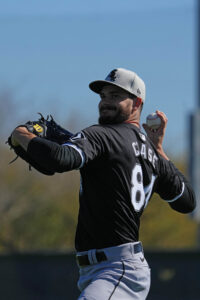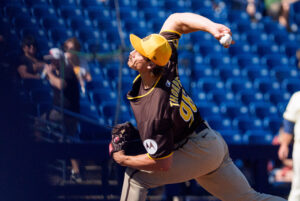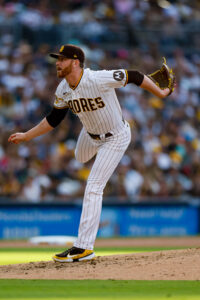The Dylan Cease saga has come to an end. The Padres announced the acquisition of the right-hander from the White Sox for four players: prospects Drew Thorpe, Jairo Iriarte and Samuel Zavala and big league reliever Steven Wilson.
Cease has been a trade candidate at least as far back as last summer’s deadline. While Chicago took him off the market at that time, first-year general manager Chris Getz made clear that he was willing to consider offers on virtually everyone on the roster going into the offseason. That made Cease one of the top names of the winter.
Chicago fielded offers early in the offseason before pulling back. The Sox indicated they wanted to wait for the free agent rotation market to play out before aggressively shopping the star righty. Blake Snell and Jordan Montgomery have lingered in free agency longer than anyone anticipated. With Opening Day two weeks away, Chicago seemed to find more urgency to make a move. They’d reportedly talked with the Yankees and Rangers within the past few days, but it is San Diego that gets the deal done.
It’s a massive strike for them just a week before they’ll open the regular season with a two-game set against the Dodgers in South Korea. For much of the offseason, the Padres have gone in the opposite direction. They faced significant payroll constraints that led to the free agent departures of Josh Hader, Seth Lugo, Nick Martinez and Michael Wacha. Snell seems likely to follow.
The biggest loss, of course, came via trade. The Padres dealt Juan Soto to the Yankees before his final year of team control. That both offloaded his arbitration salary — which eventually checked in at $31MM — and brought back a number of controllable starting pitchers to compensate for the free agent departures. Michael King will step into the middle of the rotation. Jhony Brito and Randy Vásquez are candidates for a back-end role. Thorpe came over in that trade and would have been in the rotation mix as well, but he’s now headed to Chicago before throwing a regular season pitch for the Padres.
Despite targeting upper level pitching in the Soto return, San Diego had a largely unproven rotation. Joe Musgrove and Yu Darvish were locked into the top two spots. King was ensured of a job after a strong finish last season with the Yankees, but he’d been a reliever for most of his major league career. He only moved to the starting staff for his final eight appearances beginning at the end of August. The rest of the starting pitching options in the organization have limited MLB experience of any kind.
Cease addresses that lack of experience. The former sixth-round pick has been a fixture of the Sox’s rotation since 2020. Aside from a brief virus-related absence in ’21, he hasn’t missed any time as a major leaguer. Cease leads the majors with 109 starts over the last four seasons.
At his best, Cease has paired that pristine durability with a top-of-the-rotation ceiling. He was dominant two seasons ago, turning in a 2.20 ERA with an excellent 30.4% strikeout rate through 184 innings. He was runner-up behind Justin Verlander in that season’s Cy Young balloting and received some down-ballot MVP consideration.

The 28-year-old didn’t replicate that ace-caliber production last season. He had a pedestrian 4.58 ERA across 177 frames. While some level of regression from a 2.20 mark always seemed likely, his earned run average more than doubling wasn’t expected. That’s partially a reflection of a dramatic swing in Cease’s batted ball fortune. Opponents hit only .260 on balls in play against him in 2022; that spiked 70 points a season ago.
Beyond the ball-in-play results, Cease was a little less overpowering in ’23 than he’d been the previous season. His swinging strike rate dipped from 15% to 13.6%. He lost three percentage points off his strikeout rate, which fell to 27.3%. The average velocity on both his fastball (95.6 MPH) and slider (86.3 MPH) dropped a tick. Those are all still better than average marks but not quite as impressive as his 2022 metrics.
As is often the case, Cease’s true talent ERA very likely falls somewhere in the middle. Going back to the start of 2020, he carries a 3.58 mark in just shy of 600 innings. That has come in a tough home ballpark for pitchers in front of generally lackluster defenses.
At the same time, Cease has never had pristine control of his high-octane stuff. He has walked more than 10% of batters faced in three of the past four seasons, including his Cy Young runner-up campaign. He issued free passes at a 10.1% clip last year. That inconsistent command has kept him from blossoming into a true ace and is part of the reason he’s “only” 16th in innings pitched over the last four seasons despite topping MLB in starts.
It’s debatable but largely immaterial where Cease slots alongside Darvish and Musgrove among San Diego’s top three starters. King moves to the #4 spot, while the Friars now have only one Opening Day rotation job up for grabs. Brito, Vásquez, knuckleballer Matt Waldron and the out-of-options Pedro Avila could each be in the mix for the role.
It’s a renewed push for contention by a San Diego front office that has never shied away from dealing for star talent. Cease becomes the defining addition of the Padre offseason, largely enabled by his affordability. He and the White Sox had agreed to an $8MM salary to avoid arbitration. He’s under control via that process through the 2025 campaign. The Padres can plug him into the rotation for the next two years for what’ll likely be between $20MM and $25MM overall.
RosterResource calculates San Diego’s 2024 player payroll around $167MM, including Cease’s salary. The trade pushes their luxury tax number around $224MM, roughly $13MM below this year’s lowest threshold. The Friars have worked to stay under the tax line after exceeding it in each of the past three seasons. They still have questions about the overall roster depth — particularly in the outfield — but they have some flexibility to continue adding either this spring or at the deadline without pushing into CBT territory.
Landing a pitcher of Cease’s caliber and affordability required parting with a few fairly well-regarded young players. San Diego was never going to trade Ethan Salas or Jackson Merrill and managed to keep young pitchers Dylan Lesko and Robby Snelling out of the deal. Thorpe, Zavala and Iriarte were all generally regarded in the next tier of Padres talents. Baseball America ranked all three between fifth and ninth in the San Diego system. The Athletic’s Keith Law had those players in the 6-9 range on his organizational prospect list.
As a key piece of the Soto return, Thorpe is probably the most well-known of the bunch. A second-round pick in 2022 out of Cal Poly San Luis Obispo, Thorpe had a breakout showing in his first full minor league season. The 6’4″ right-hander worked to a 2.52 ERA in 23 starts between High-A and Double-A last year. He fanned more than a third of opposing hitters against a modest 7.1% walk rate.

Thorpe doesn’t light up radar guns with a fastball that sits in the low-90s. Evaluators credit him with a plus or better changeup and an above-average breaking ball, though. He has shown advanced strike-throwing acumen, although Law writes that his precise command (the ability to spot pitches where he wants them) isn’t as impressive as his control (hitting the strike zone consistently). Baseball America, FanGraphs and ESPN’s Kiley McDaniel all placed Thorpe in the back half of the league’s Top 100 prospects this winter. He’s a potential mid-rotation arm who could impact the Sox as soon as this year.
Iriarte, a 6’2″ righty from Venezuela, could also be part of the major league pitching staff at some point in 2024. The 22-year-old worked 90 1/3 frames across 27 appearances between High-A and Double-A last season. He allowed 3.49 earned runs per nine behind a 33.2% strikeout percentage. He also walked almost 12% of opposing hitters, but there’s clear bat-missing potential.
Evaluators credit Iriarte with upper 90s velocity with a plus slider and a promising but inconsistent changeup. The chance for three above-average to plus offerings gives him significant upside, although evaluators are split on whether he’ll stick as a starting pitcher. He’ll need to refine his secondary stuff and continue to improve his control, but his athleticism gives him the opportunity to do so. FanGraphs slotted Iriarte in the back half of their Top 100 list. The Sox can take their time to afford him plenty of reps in the upper minors.
Zavala, 19, is a further away development flier. The lefty-hitting outfielder was one of the better prospects in the 2020-21 international signing period. He spent most of last season at Low-A Lake Elsinore. Zavala’s .267/.420/.451 batting line is impressive for a player his age, but prospect evaluators are divided on his long-term upside. Law suggests he’s unlikely to stick in center field, while most reports question his pure contact skills. Zavala took plenty of walks but also struck out at an alarming 27.2% clip in Low-A.
Wilson might be the fourth piece of the return, but he should step directly into the big league bullpen. The 29-year-old righty has been a quality reliever in each of the last two seasons. Wilson owns a 3.48 ERA across 106 career innings. He has fanned just over a quarter of opposing hitters against a 10.9% walk rate. Wilson leans heavily on a low-80s breaking ball and sits in the mid-90s with his fastball.

That profile has led to better strikeout and walk numbers versus right-handed batters, but Wilson has gotten decent results against hitters of either handedness. He could step into high-leverage work in a completely open Sox bullpen. The Santa Clara product has exactly two years of service. Chicago controls him through at least 2027, depending on whether they option him to the minors at any point. He won’t be eligible for arbitration until next offseason.
The White Sox had named Cease their Opening Day starter. That’s no longer on the table as they commit even further to a retool. KBO returnee Erick Fedde is perhaps the top pitcher in what might be the weakest rotation in the American League. Michael Soroka, Chris Flexen, Michael Kopech, Garrett Crochet and Jared Shuster are among the other possibilities. Thorpe figures to open the season in Triple-A but could pitch his way into the mix before long.
Chicago could go outside the organization to try to backfill some of their lost innings. Ken Rosenthal of the Athletic reported last night that the Sox had interest in Michael Lorenzen as a potential Cease replacement. Zack Greinke, Jake Odorizzi and old friend Johnny Cueto also remain unsigned.
Iriarte and Wilson are each on the 40-man roster. Thorpe and Zavala won’t be eligible for the Rule 5 draft until the 2025-26 offseason, although Thorpe seems likely to pitch his way onto the MLB roster well before that point. Chicago designated outfielder Peyton Burdick for assignment to open the necessary 40-man spot.
ESPN’s Jeff Passan first reported the Padres were finalizing a trade for Cease. Jon Heyman of the New York Post confirmed a Cease agreement was in place. Jon Morosi of MLB.com was first to report the White Sox were acquiring Thorpe and Iriarte. The Athletic’s Dennis Lin first reported Wilson’s inclusion. Bob Nightengale of USA Today was first with Zavala being in the deal.
Images courtesy of USA Today Sports.